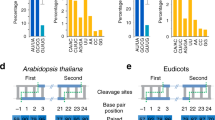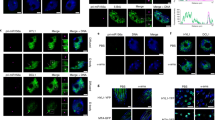Abstract
MicroRNAs (miRNAs) in plants and animals function as post-transcriptional regulators of target genes, many of which are involved in multicellular development. miRNAs guide effector complexes to target mRNAs through base-pair complementarity, facilitating site-specific cleavage or translational repression. Biogenesis of miRNAs involves nucleolytic processing of a precursor transcript with extensive foldback structure. Here, we provide evidence that genes encoding miRNAs in plants originated by inverted duplication of target gene sequences. Several recently evolved genes encoding miRNAs in Arabidopsis thaliana and other small RNA–generating loci possess the hallmarks of inverted duplication events that formed the arms on each side of their respective foldback precursors. We propose a model for miRNA evolution that suggests a mechanism for de novo generation of new miRNA genes with unique target specificities.
This is a preview of subscription content, access via your institution
Access options
Subscribe to this journal
Receive 12 print issues and online access
$209.00 per year
only $17.42 per issue
Buy this article
- Purchase on Springer Link
- Instant access to full article PDF
Prices may be subject to local taxes which are calculated during checkout







Similar content being viewed by others
References
Bartel, D. MicroRNAs: genomics, biogenesis, mechanism, and function. Cell 116, 281–297 (2004).
Ketting, R.F. et al. Dicer functions in RNA interference and in synthesis of small RNA involved in developmental timing in C. elegans. Genes Dev. 15, 2654–2659 (2001).
Hutvagner, G. et al. A cellular function for the RNA-interference enzyme Dicer in the maturation of the let-7 small temporal RNA. Science 293, 834–838 (2001).
Lee, Y. et al. The nuclear RNase III Drosha initiates microRNA processing. Nature 425, 415–419 (2003).
Park, W., Li, J., Song, R., Messing, J. & Chen, X. CARPEL FACTORY, a Dicer homolog, and HEN1, a novel protein, act in microRNA metabolism in Arabidopsis thaliana . Curr. Biol. 12, 1484–1495 (2002).
Kurihara, Y. & Watanabe, Y. Arabidopsis micro-RNA biogenesis through Dicer-like 1 protein functions. Proc. Natl. Acad. Sci. USA 101, 12753–12758 (2004).
Reinhart, B.J., Weinstein, E.G., Rhoades, M.W., Bartel, B. & Bartel, D.P. MicroRNAs in plants. Genes Dev. 16, 1616–1626 (2002).
Finnegan, E.J. & Matzke, M.A. The small RNA world. J. Cell Sci. 116, 4689–4693 (2003).
Floyd, S.K. & Bowman, J.L. Gene regulation: ancient microRNA target sequences in plants. Nature 428, 485–486 (2004).
Pasquinelli, A.E. et al. Conservation of the sequence and temporal expression of let-7 heterochronic regulatory RNA. Nature 408, 86–89 (2000).
Meyerowitz, E.M. Plants compared to animals: the broadest comparative study of development. Science 295, 1482–1485 (2002).
Poethig, R.S. Life with 25,000 genes. Genome Res. 11, 313–316 (2001).
Jones-Rhoades, M.W. & Bartel, D.P. Computational identification of plant microRNAs and their targets, including a stress-induced miRNA. Mol. Cell 14, 787–799 (2004).
Griffiths-Jones, S., Bateman, A., Marshall, M., Khanna, A. & Eddy, S.R. Rfam: an RNA family database. Nucleic Acids Res. 31, 439–441 (2003).
Palatnik, J.F. et al. Control of leaf morphogenesis by microRNAs. Nature 425, 257–263 (2003).
Aukerman, M.J. & Sakai, H. Regulation of flowering time and floral organ identity by a microRNA and its APETALA2-like target genes. Plant Cell 15, 2730–2741 (2003).
Chen, X. A microRNA as a translational repressor of APETALA2 in Arabidopsis flower development. Science 303, 2022–2025 (2004).
Mallory, A.C., Dugas, D.V., Bartel, D.P. & Bartel, B. MicroRNA regulation of NAC-domain targets is required for proper formation and separation of adjacent embryonic, vegetative, and floral organs. Curr. Biol. 14, 1035–106 (2004).
Achard, P., Herr, A., Baulcombe, D.C. & Harberd, N.P. Modulation of floral development by a gibberellin-regulated microRNA. Development 131, 3357–3365 (2004).
Emery, J.F. et al. Radial patterning of Arabidopsis shoots by class III HD-ZIP and KANADI genes. Curr. Biol. 13, 1768–1774 (2003).
Laufs, P., Peaucelle, A., Morin, H. & Traas, J. MicroRNA regulation of the CUC genes is required for boundary size control in Arabidopsis meristems. Development 131, 4311–4322 (2004).
Sunkar, R. & Zhu, J.K. Novel and stress-regulated microRNAs and other small RNAs from Arabidopsis . Plant Cell 16, 2001–2019 (2004).
Xie, Z., Kasschau, K.D. & Carrington, J.C. Negative feedback regulation of Dicer-Like1 in Arabidopsis by microRNA-guided mRNA degradation. Curr. Biol. 13, 784–789 (2003).
Vaucheret, H., Vazquez, F., Crete, P. & Bartel, D.P. The action of ARGONAUTE1 in the miRNA pathway and its regulation by the miRNA pathway are crucial for plant development. Genes Dev. 18, 1187–117 (2004).
Levine, M. & Tjian, R. Transcription regulation and animal diversity. Nature 424, 147–151 (2003).
Teichmann, S.A. & Babu, M.M. Gene regulatory network growth by duplication. Nat. Genet. 36, 492–496 (2004).
Rhoades, M.W. et al. Prediction of plant microRNA targets. Cell 110, 513–520 (2002).
Vazquez, F., Gasciolli, V., Crete, P. & Vaucheret, H. The nuclear dsRNA binding protein HYL1 is required for microRNA accumulation and plant development, but not posttranscriptional transgene silencing. Curr. Biol. 14, 346–351 (2004).
Dunoyer, P., Lecellier, C.H., Parizotto, E.A., Himber, C. & Voinnet, O. Probing the microRNA and small interfering RNA pathways with virus-encoded suppressors of RNA silencing. Plant Cell 16, 1235–1250 (2004).
Llave, C., Kasschau, K.D., Rector, M.A. & Carrington, J.C. Endogenous and silencing-associated small RNAs in plants. Plant Cell 14, 1605–1619 (2002).
Papp, I. et al. Evidence for nuclear processing of plant micro RNA and short interfering RNA precursors. Plant Physiol. 132, 1382–1390 (2003).
Xie, Z. et al. Genetic and functional diversification of small RNA pathways in plants. PLoS Biol. 2, E104 (2004).
Peragine, A., Yoshikawa, M., Wu, G., Albrecht, H.L. & Poethig, R.S. SGS3 and SGS2/SDE1/RDR6 are required for juvenile development and the production of trans-acting siRNAs in Arabidopsis . Genes Dev. 18, 2368–2379 (2004).
Vazquez, F. et al. Endogenous trans-acting siRNAs regulate the accumulation of Arabidopsis mRNAs. Mol. Cell 16, 69–79 (2004).
Schauer, S.E., Jacobsen, S.E., Meinke, D.W. & Ray, A. DICER-LIKE1: blind men and elephants in Arabidopsis development. Trends Plant Sci. 7, 487–491 (2002).
Holder, M. & Lewis, P.O. Phylogeny estimation: traditional and Bayesian approaches. Nat. Rev. Genet. 4, 275–284 (2003).
Mallory, A.C. et al. MicroRNA control of PHABULOSA in leaf development: importance of pairing to the microRNA 5′ region. EMBO J. 23, 3356–3364 (2004).
Kasschau, K.D. et al. P1/HC-Pro, a viral suppressor of RNA silencing, interferes with Arabidopsis development and miRNA unction. Dev. Cell 4, 205–217 (2003).
Bartel, B. & Bartel, D.P. MicroRNAs: at the root of plant development? Plant Physiol. 132, 709–717 (2003).
Llave, C., Xie, Z., Kasschau, K.D. & Carrington, J.C. Cleavage of Scarecrow-like mRNA targets directed by a class of Arabidopsis miRNA. Science 297, 2053–2056 (2002).
Herbert, A. The four Rs of RNA-directed evolution. Nat. Genet. 36, 19–25 (2004).
Bartel, D.P. & Chen, C.Z. Micromanagers of gene expression: the potentially widespread influence of metazoan microRNAs. Nat. Rev. Genet. 5, 396–400 (2004).
Hurles, M. Gene duplication: the genomic trade in spare parts. PLoS Biol. 2, E206 (2004).
Rice, P., Longden, I. & Bleasby, A. EMBOSS: the European Molecular Biology Open Software Suite. Trends Genet. 16, 276–277 (2000).
Hofacker, I.L. Vienna RNA secondary structure server. Nucleic Acids Res. 31, 3429–3431 (2003).
Lin, J.-T. Alternatives to Hamaker's approximations to the cumulative normal distribution and its inverse. Statistician 37, 413–414 (1988).
Notredame, C., Higgins, D.G. & Heringa, J. T-Coffee: A novel method for fast and accurate multiple sequence alignment. J. Mol. Biol. 302, 205–217 (2000).
Huelsenbeck, J.P. & Ronquist, F. MRBAYES: Bayesian inference of phylogenetic trees. Bioinformatics 17, 754–755 (2001).
Posada, D. & Crandall, K.A. MODELTEST: testing the model of DNA substitution. Bioinformatics 14, 817–818 (1998).
Swofford, D PAUP*: Phylogenetic analysis using parsimony (*and other methods) 4.0b10 edn. (Sinauer, Sunderland, Massachusetts, 2002).
Acknowledgements
We thank S. Givan, D. Smith and C. Sullivan for assistance and advice with computational resources; L. Johansen for initial propagation of the rdr6-15 mutant; and S. Poethig and H. Vaucheret for discussions about trans-acting siRNAs and the suggestion to analyze miR161 in multiple dcl1 mutated alleles. This work was supported by grants from the US National Science Foundation, the US National Institutes of Health and the United States Department of Agriculture.
Author information
Authors and Affiliations
Corresponding author
Ethics declarations
Competing interests
The authors declare no competing financial interests.
Supplementary information
Supplementary Fig. 1
Predicted foldback structures for small RNA generating loci containing inverted repeats with similarity to protein coding genes. (PDF 48 kb)
Supplementary Table 1
MIRNA genes and small RNA-generating loci used for FASTA searches presented in Figure 2. (XLS 39 kb)
Rights and permissions
About this article
Cite this article
Allen, E., Xie, Z., Gustafson, A. et al. Evolution of microRNA genes by inverted duplication of target gene sequences in Arabidopsis thaliana. Nat Genet 36, 1282–1290 (2004). https://doi.org/10.1038/ng1478
Received:
Accepted:
Published:
Issue Date:
DOI: https://doi.org/10.1038/ng1478
This article is cited by
-
Identification and expression analysis of SQUAMOSA promoter-binding protein (SBP) genes in mungbean
Plant Biotechnology Reports (2023)
-
Genome-wide identification of MITE-derived microRNAs and their targets in bread wheat
BMC Genomics (2022)
-
Genome-wide miRNA analysis and integrated network for flavonoid biosynthesis in Osmanthus fragrans
BMC Genomics (2021)
-
A transposon surveillance mechanism that safeguards plant male fertility during stress
Nature Plants (2021)
-
Unravelling the developmental and functional significance of an ancient Argonaute duplication
Nature Communications (2020)



